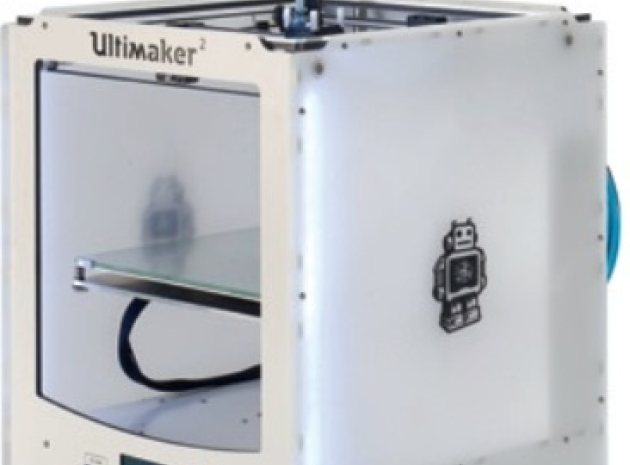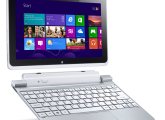At the Science Museum in London there’s currently a free exhibition devoted to 3D printing, which ends in January 2015 and showcases over 600 objects. It’s absolutely mind-blowing and incredibly inspiring; I highly recommend it.
Schools are in the early adoption of 3D printer technology and the potential is massive. There are lots of important considerations to factor in when choosing a printer including the speed of printing, the interface between the printer and the files to be printed, cost of consumables, ease of use, compatibility of firmware with school operating systems and networks and quality and accessibility of aftersales support.
One award winning DIY printer definitely worth a look is the Ultimaker 2, the brainchild of Ultimaker BV founded by three Dutch entrepreneurs. This attractive robot has been designed for novice and skilled users and is ideal for school use. It has an open front, translucent sides and interior that is splendidly lit up by strings of lights and a generous build volume. It measures around 38cm x 35cm x 34cm, weighs about 11kg and is built out of premium parts and materials to world class specifications. It comes with cables and user manual and the full starter package, which includes filament reel, SD-card, glue stick, grease and hex wrenches.
The Ultimaker 2 brands itself as an easy and very reliable printer that everyone can use to start printing right away, so I put that claim to the test without delay. There is a fair bit of setting up to do but the excellent user manual guides you through each step, and it’s not too complicated. It’s a fantastic looking box when powered up and looks like something from a state of the art lab. Now the obvious aim is to design your own 3D model but to get started there are some models already loaded onto the SD Card such as an earring circle and stackable cup. I chose to print a mini-robot. Once I had selected my model and after a bit of heating up the printing started. I was mesmerised. Bit by bit layer by layer, a robot was built before my very eyes and the detail and precision was very impressive.
The results? Well, my expectations were high but the printer exceeded them by a mile. I was impressed with how quiet it was. I expected a fair amount of noise but it hummed no louder than a quiet conversation. It wasn’t as fast as I thought it would be - the model took 45 minutes to build, which is worth remembering for lessons when more complicated builds are planned. But it is the precision that really impresses. I can’t get over just how accurate it is. My robot was crafted in detail and to a very high standard. This got me thinking. I could create my own 3 dimensional visual aids. I could challenge any class to produce realistic 3D mini-models. Think what you could do in science. How about creating a model of the human heart for example? If you are not afraid to experiment and innovate then Ultimaker 2 is a teaching resource with enormous potential.
You can also download ideas from the online community YouMagine.com. I chose the Champions League Trophy, but other options included an obelisk, maracas, glasses and even a Star Wars light saber. Before this though, I had to run some software from Ultimaker called Cura, which includes everything you need to prepare a 3D file for printing. What the intuitive Cura does is slice a model in layers so that the printer knows what to print. It’s easy to use and you can resize and move things without a problem. My trophy is just as impressive as the robot and is made to such a high standard I’m using it as a reward for good behaviour.
I did encounter problems with the Ultimaker 2. After a couple of models the nozzle got blocked and that meant the melted plastic didn’t squirt out the way it should, which was hugely frustrating because it wasn’t easy to resolve and involved a lot of time getting things back on track. The models I did create sometimes got stuck to the glass plate as well, but that was more user error than anything as you apply some glue to the glass to stop this happening. I am puzzled by the fact that Ultimaker doesn’t support printing over a USB connection. Instead there is an SD card slot and the Ultimaker 2 comes with a 4GB card and some test files loaded. There is a USB port on there but apparently this is for firmware updates only. I thought the robot was Wi-Fi ready but it isn’t and requires an accessory at extra cost to connect wirelessly. The only other thing I’d like to see is more online video support materials for the faint-hearted so teachers and learners can familiarise themselves more with the potential and possibilities. Lesson plans would be perfect please.
3D printing is on track to change the shape of lessons forever. If you can jump over the usual barriers of access, funding, teacher awareness and confidence then the Ultimaker 2 could be a giant leap for your school. Stick one in your fab lab, see what digital ideas students can produce in 3D form and watch their creativity and independence grow.
Solid success
The Ultimaker 2 is the ultimate out of the box 3D printer, with a reliability and durability that schools will love.
Key Resource: Peltier Cells
Peltier Cells is a comprehensive set of materials giving teachers all the background they need to teach this interesting concept. Peltier cells use electrical energy to heat or cool materials, with applications in the food preservation, packaging, and medical industries. This resource from the Design and Technology Association gives students an opportunity to use and develop their creative skills in developing ideas for new products. It starts with an investigation of a scientific principle, leading to a designing and making activity resulting in design proposals in the form of working prototypes. Students will research Peltier cells and their applications and design and make products with real, practical applications. The resource contains an introduction, full lesson plans, homework activities and a full teacher guide and plan of work.
Go to the resource shop at www.data.org.uk










